How the world’s best zoos are working to save biodiversity in an age of extinction.

Tiger meets human at the Minnesota Zoo. Physical spaces where people can easily encounter and connect with wild species, zoos and aquariums are unique institutions. Yet in an age of environmental crises, are they doing enough to save species from extinction? Photo by: Tara Harris.
What is a zoo? Is it a place of entertainment or education? Of cages or conservation? Beginning around the mid-Twentieth Century, zoos and aquariums underwent a revolution of sorts: they began to see their animals less as captives and more as charges, while viewing their role within the community as increasingly educational. Many abolished barred cages for larger and more natural-looking pens, added enrichment activities to keep animals engaged, and began to take education more seriously, especially as the realization of a biodiversity crisis began to permeate the public consciousness. This revolution in zoos has been well-documented. But a quieter revolution in zoos has also been occurring over just the past twenty-five years. Rather than just stand by the sidelines as species vanish in the wild, more and more zoos have begun funding on-the-ground conservation efforts, some even going so far as launching their own conservation programs. While this revolution has been less visible than spruced-up pens and educational outreach, it signals a widening realization by zoos of the positive—and wholly unique—role they could play in combatting global mass extinction. But the question remains: are zoos doing enough?
“There is increasing recognition that collectively we have the potential to be one of the biggest forces for wildlife conservation worldwide and that we have a responsibility to do more,” said Tara Harris, Director of Conservation at the Minnesota Zoo, which has long been leader in conservation field efforts, especially for tigers. “The species we exhibit are disappearing in the wild at an alarming rate, and the threats to their existence will only increase over the course of this century. Zoos and aquariums are poised to make a dramatic difference. Unlike most conservation organizations, we have physical spaces where millions of people—more than those that visit professional football, basketball, baseball, and hockey games combined—come to connect with animals.”
Today, the Minnesota Zoo supports a number of local conservation initiatives while expanding its work abroad to include black rhinos, Asian wild horses, and dholes.
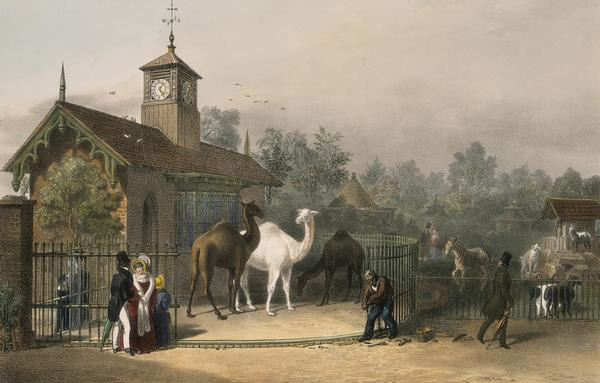
Painting of zoo in Regent’s Park, London in 1835. Zoological institutions have changed considerably in the last two centuries. Painter unknown.
Other innovative zoos are also working to translate this connection between visitors and animals into action in the wild. Three years ago, the Chester Zoo in the UK kicked off its Act for Wildlife campaign, which is aimed at fundraising to help species and ecosystems in crisis. Currently the campaign, fully supported by Chester Zoo, is helping to raise awareness and money for eight wildlife projects from China to Nigeria.
“Zoos have evolved over the last century and the modern zoo’s mission is biodiversity conservation. To achieve this we must work inside and outside of the zoo—protecting species and habitats directly in the field,” said Catherine Barton, Assistant Conservation Officer with Chester Zoo, adding that zoos can bring distinct experience to field conservation projects such as veterinary services, educational outreach, and captive breeding.
Still, when asked if zoos are doing enough, over and over they said “no.”
Tony Vecchio has held the highest position of director at three zoos in the U.S.—Roger Williams Zoo, Oregon Zoo, and most recently Jacksonville Zoo and Gardens—and is known in the zoo world for passionately supporting field conservation efforts wherever he’s worked. He says cumulative efforts to date are falling far short.
-CZ.600.jpg)
Chester Zoo’s Act for Wildlife supports the Assam Haathi Project in India, which is mitigating conflict between local people and elephants. Photo courtesy of: Act for Wildlife.
“I don’t believe anyone is doing ‘enough’ to combat biodiversity loss. Zoos and aquariums need to do more. Governments need to do more. Conservation organizations, individuals, corporations all need to do more,” he said. “It makes me crazy that when political pollsters ask people to list the most pressing problems, conservation and the environment rarely make the top five recognized problems.”
As places where the pubic can connect with live animals—many of them endangered in the wild—zoos and aquariums have a unique capacity to convince the public to support the conservation of nature. Yet acknowledging the role zoos and aquariums could play and actually achieving major successes are two different things. Meanwhile, the reality of conservation in the wild is that it first-of-all depends on one thing: funding.
The Money
Zoos and aquariums have been talking up conservation for over a century. For a long time, however, this meant sometimes-nebulous education goals and captive breeding. Today, some institutions are finally putting their money where their mission is. For example, in 2008 zoos and aquariums worldwide spent an estimated $350 million on wildlife conservation, a term that includes both captive breeding within zoos and field conservation. During that same year, approximately 700 million people visited zoos and aquariums worldwide, according to the World Association of Zoos and Aquariums (WAZA), which works with zoos worldwide on animal care, education, and conservation. This means zoos and aquariums spent on average approximately $0.50 on conservation per visitor.
However, there is a caveat: most of this money is only coming from a few forward-thinking institutions.
For example, in the U.S.—where zoos spent $160 million on conservation efforts in 2012 or nearly half the global total—75 percent of this conservation funding came from just 14 institutions, according to the Association of American Zoos (AZA). And one zoological institution rises above them all. Of the $160 million spent in the U.S., half comes from the Wildlife Conservation Society (WCS), which runs four zoos and one aquarium in the New York City metropolitan area. An early forerunner in wildlife programs, this organization is distinct for seamlessly bridging the gap between zoological institutions and global conservation efforts.

The Wildlife Conservation Society’s (WCS) Bronx Zoo. Running four zoological institutions, WCS funds more conservation work than any other zoo in the world. Photo by: Postdlf/Creative Commons 3.0.
“The truth is there are a handful of zoos that can be relied on when looking for support for field colleagues—that are responsive to requests and have the leeway to respond to a crisis or emergency or just able to offer funding to a new but untested field project,” said Beth Armstrong, a co-founders of ZACC (Zoos and Aquariums Committing to Conservation) and Steering Committee Chair for the organization, pointing to early leaders like Columbus Zoo, Woodland Park Zoo, Cleveland Zoo, Roger Williams Park Zoo, Oregon Zoo, Jacksonville Zoo, and Disney’s Animal Kingdom through its Disney Worldwide Conservation Fund.
“AZA-accredited zoos and aquariums worked on conservation projects supporting over 650 different species, more than 200 of which are listed under the U.S. Endangered Species Act,” said Shelly Grow, the Director of Conservation Programs with AZA. “The reach…is truly global: projects took place in more than 115 countries around the world.”
But even small zoos and aquariums can have a big impact on particular species. In fact, they are sometimes the first place to support lesser-known, smaller conservation projects unconnected with the big NGOs. They have become vital in financially supporting the efforts of hundreds of conservationists, who spend their lives working on-the-ground to save a particular species or ecosystem.
Arnaud Desbiez is one of these conservationists. Working with one of the world’s least known big mammals—the giant armadillo—Desbiez has depended almost entirely on funding from zoos. Not only is Desbiez employed by the Royal Zoological Society of Scotland, which operates the Edinburgh Zoo and the Highland Wildlife Park, but his project has received funding from over 25 zoos since just 2010.
.600.jpg)
Arnaud Desbiez (left) releases a giant armadillo after the animal has been examined and tagged with a tracking device. Most of the funding for Desbiez’s work comes from zoos. Photo courtesy of the Pantanal Giant Armadillo Project.
“If you look at what [zoos] have achieved in the past 25 years it is pretty amazing. You will now find that conservation, especially field conservation, is very much growing within zoos,” Desbiez said.
Grants from zoos have made up 85 percent of funding for Desbiez’s Pantanal Giant Armadillo Project. Even more remarkable is that this funding is going to a species that isn’t registered in a single zoo collection in the world. The funding has allowed Desbiez and his team to document giant armadillo reproduction for the first time, including photos and videos of a whole series of giant armadillo babies, taking data that will prove vital if we are to keep giant armadillos from vanishing.
Anna Nekaris, who heads the Little Fireface Project, a research and conservation group on slow loris species, has also received funding and support from a variety of zoological institutions.
“I have worked with many great zoos who indeed feel their animals are ambassadors for the wild, and are huge supporters of conservation efforts,” she said, pointing specifically to Brevard Zoo, Columbus Zoo, Cleveland Zoo, Henry Doorly Zoo, and the Shaldon Wildlife Trust. “Zoos have done ‘runs’ for loris conservation, donated paintings for auctions, developed a super cute slow loris plush toy to sell in their shops with proceeds going to conservation, amongst many other unique ideas.”
Desbiez and Nekaris represent just two conservationists whose success has depended to some extent on zoo funding.
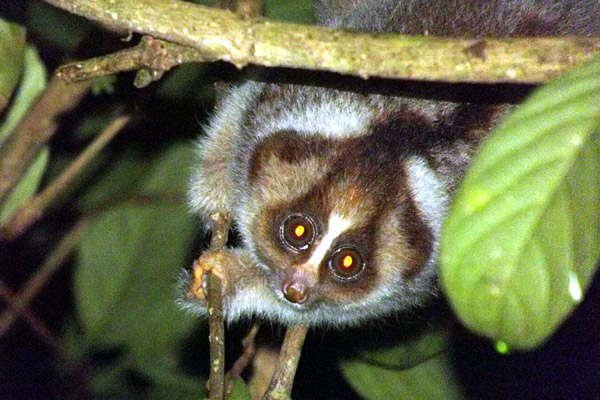
The recently described Kayan slow loris. Nekaris’ Little Fireface Project works to save the world’s loris species. The researcher was also one of the scientists who identified this new slow loris species as distinct from others. Photo by: Jmiksanek/Creative Commons 3.0.
“Just think how powerful a force zoos could be if every single one of them committed a certain amount of their annual budget to support [field] work,” noted Armstrong.
Today those that make such hard commitments are still in the minority, and total zoo commitment remains relatively small compared to budgets. For example, AZA-accredited zoos spent just two percent of their budgets on field conservation in 2012. However even this number is warped by the outsized commitment from WCS and the fact that some institutions contribute nothing. There is an ongoing effort to raise this to three percent across AZA zoos.
“It takes a lot of effort to raise or make enough money to operate a zoo,” said Tara Harris with the Minnesota Zoo. “People tend to go to zoos for ‘smart fun’ and to connect with animals, and those preferences drive funding priorities. There’s less public pressure for zoos to spend money on field conservation.”
Still, while funding fieldwork remains paramount in the zoo-conservation relationships, partnerships often go well beyond money, especially as relationships are cultivated.
Beyond the money
Money can be easily counted, but global conservation efforts depend on many things that are more difficult to measure, such as raising awareness, environmental education, and media attention.
“Zoos bring us much more than just financial support, and if you know how to create and maintain the partnership there are many advantages for the field project,” Desbiez said. His Giant Armadillo Project has depended on collaborations with zoos to create educational material, send out press releases, and even find volunteers.
Desbiez says he also consistently turns to zoo workers for their unique expertise.
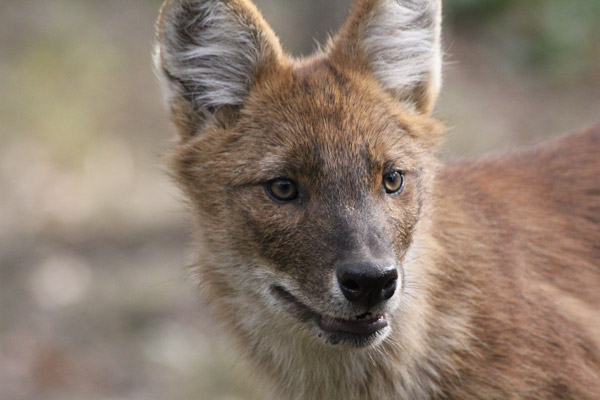
A dhole. The Minnesota Zoo, in partnership with the Smithsonian Conservation Biology Institute (SCBI), is studying and working with dhole populations in Thailand. Photo by: Tara Harris.
“Whether it is to review an anesthetic protocol, discuss a particular behavior, review a paper we wrote, give advice on equipment or even help develop a fundraising strategy, advice from zoo professionals is very much appreciated and most often fundamental. This is certainly something we use and abuse as much as we can. It is amazing how generous people working in zoos are with their time and expertise.”
For conservationists who work with animals that are commonly found in zoos—such as slow lorises—raising awareness is even more straightforward. In fact, according to Nekaris, one can employ the zoo-going public to help build local pride for native species half-way around the world.
“Many people in…the UK or the USA will never go to the Asian jungles to see a slow loris, but for some reason, maybe seeing one in a zoo, they really love slow lorises!” said Nekaris. “So by imparting this love, through drawings, stories and photographs, and sharing them with the villagers in Java who live around the slow loris, they can become proud that the animals they protect are loved all over the world.”
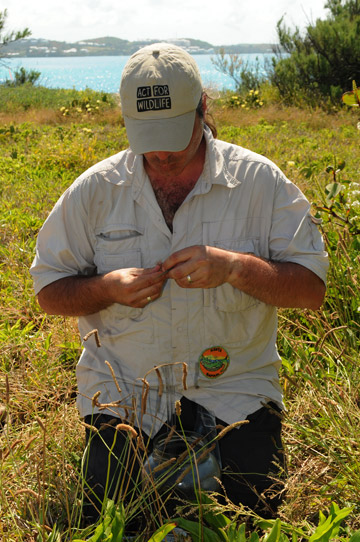 Gerardo Garcia with Chester Zoo’s Act for Wildlife collects Bermuda rock skinks on Southampton Island. Recently the Chester Zoo brought several pairs of the Critically Endangered Bermuda rock skink to the zoo as an insurance policy against extinction. Captive breeding is only of the earliest efforts zoos made towards conservation. Photo courtesy of Act for Wildlife. |
For Desbiez, the situation is complicated by the fact that giant armadillos are not housed in any zoos worldwide, limiting education and fundraising opportunities for the species. In fact, some zoos have a policy of only working with species that they have on display. Still, Desbiez has spent years cultivating long-term partnerships with a wide-variety of zoos.
“I actually named some of the animals we monitor after some individuals in the zoos we work with,” he said. “One person was so pleased that he asked for a picture of the giant armadillo named after him so he could frame it and put it in his office! This friendly close relationship is something we really cherish and value.”
Desbiez highlights a vital point: connecting zoo staff with scientists around the world has led to the creation of “conservation families,” some of which have lasted many years. Like any idealized family, all sides benefit: not only do conservationists gain funds, expertise and moral support, but the zoo workers become connected to conservation efforts in the wild, learn from scientists on the ground, and feel as if they are making a difference in the battle to save the world’s species.
“Most zoo animal staffers are hard-core conservationists,” said Tony Vecchio head of the Jacksonville Zoo and Gardens. “We believe we have a moral and ethical obligation to dedicate our live to saving the world’s wildlife and wild places.”
By working directly with conservationists, zoo staffers participate in just that.
Involving the public
While some zoos and aquariums have managed to fund field work and offer expertise, those that really standout are the institutions that share their conservation partners with the public, leveraging the partnerships as both a teaching and fundraising tool, according to experts.
“Unlike big conservation organizations like CI, WWF, and the Nature Conservancy, zoos are an actual destination, a place for people to visit, to wander, to browse. Those zoos that have incorporated their conservation stories (the field projects they support) throughout their zoo exhibits, then offer the public the opportunity to give dollars—those are the ones that I consider innovative,” said Armstrong with ZACC or Zoos and Aquariums Committing to Conservation.
-CZ.600.jpg)
Local school children meet with Maggie Esson in Tanzania. Chester Zoo’s Act for Wildlife is working with the George Adamson Wildlife Preservation Trust in Mkomazi National Park with a focus on conserving black rhinos. Photo courtesy of: Act for Wildlife.
Beginning in 1995, ZACC has held a conference every two years that bring zoos, aquariums, and in-field conservationists together for candid discussions about how to increase collaborative efforts between the world’s zoos and scientists.
“The ultimate goal of ZACC has been to shift the culture in zoos, i.e. to incorporate a commitment to fieldwork that is just part of doing business, that it is just a normal part of daily operations,” explained Armstrong. “We are not there yet and it’s taking longer than anticipated but each time a person leaves a ZACC conference inspired to do more, to carry that message forward, to be willing to go back to their institution and be an advocate for change then we’ve accomplished something.”
In fact, the conferences have become a forum for new ideas about not only how to help field conservationists, but also how to relay their stories to a distracted public.
“Many people aren’t fully aware of the great work that zoos are doing to save animals in nature,” noted Harris.
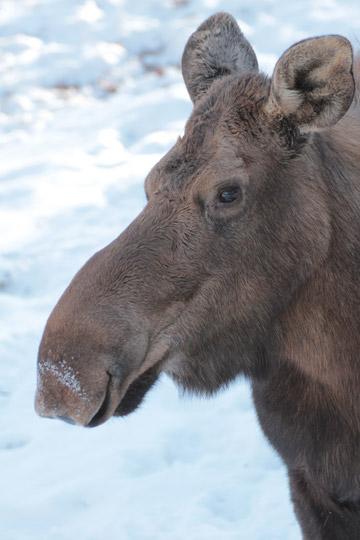 The Minnesota Zoo is working with research efforts looking at why moose are vanishing from the state. Photo by: Tara Harris. |
Vecchio agrees. “Many people in the community and even on zoo boards don’t recognize zoos as conservation organizations,” he said. “They believe a zoo’s role is to serve the community by being a clean, safe, family-oriented, recreational opportunity.”
In fact, a recent global survey by WAZA—interviewing over 6,357 visitors to over 30 zoos—found that only 4.5 percent of zoo visitors said they could help global biodiversity by supporting their local zoos or aquariums—and this was after the visitors spent the day at the institutions. The same survey found that a visit to a zoo or aquarium boosted the percentage of visitors who displayed an understanding of biodiversity, but only by 5.3 percent. Moreover, respondents only needed to display a remedial understanding of what biodiversity means.
Clearly, as the survey shows, these institutions have a long way to go. To this end, many have turned to a number of avenues to educate their visitors about their field conservation work. For example, some zoos have begun to incorporate information about their specific efforts directly into their displays, including a chance for visitors to donate to specific programs. Other efforts include training employees to talk to visitors about the zoo’s efforts or hosting partner conservationists for fundraising trips and lectures. But as zoos and aquariums feel the need to do more, new ideas are being implemented.
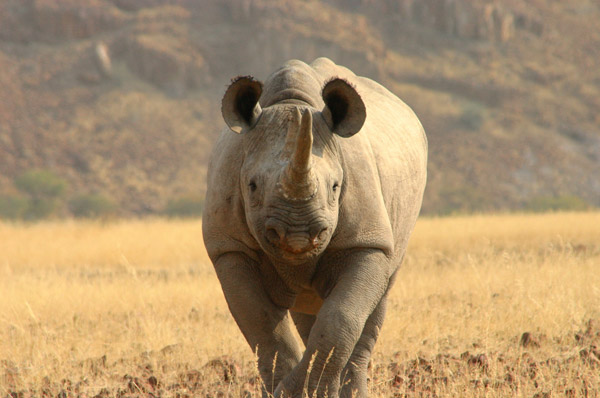
The Minnesota Zoo supports conservation efforts of black rhinos in Namibia along with Save the Rhino Trust (SRT). Photo by: Tara Harris.
“One idea that’s catching on and making a big difference is ‘Quarters for Conservation.’ The idea is pretty simple—a zoo adds 25 cents onto the price of admission and allows its visitors to choose where they want their quarter to go, from a list of pre-selected field conservation projects,” explained Harris who says the program has been successful at many institutions. “Zoos that have implemented this program have seen big increases in the amount they’re able to spend on field conservation.”
Created by Zoo Boise in 2007 under the guidance of director Steven Burns, Quarters for Conservation can now be found in over a dozen zoos in the U.S. One of the biggest advantages of the program is it provides a direct way to leave no visitor behind when educating about conservation partners, since every visitor votes for their favorite program after paying the entrance fee. Programs are carefully selected by the institution and often change every few years. Perhaps even more importantly, it gives visitors a sense of empowerment and hope when it comes to conservation.
The Chester Zoo has taken the idea of empowering the public even further: they’ve implemented an online campaign to not only help fundraise for field projects, but also to get people to change environmentally-damaging behavior.
“Through Act for Wildlife, we’re…able to reach a slightly different audience [than average zoo visitors] and push out different messages, from encouraging the public to purchase sustainable palm oil products to bringing together local people to assist in wildlife recording events and native species conservation,” explained Catherine Barton.
Act for Wildlife also views blogging as a powerful tool for conservation efforts.
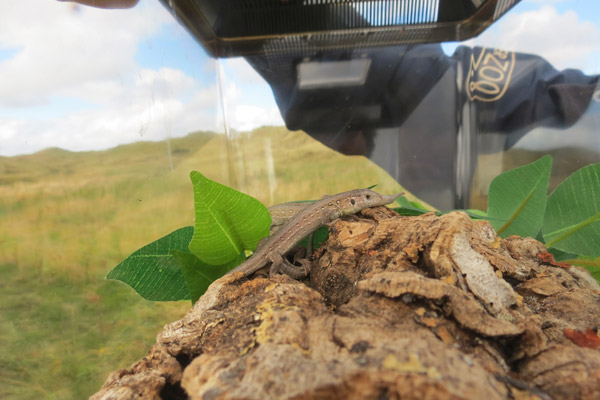
Sand lizard in terrarium. Chester Zoo’s Act for Wildlife works with local species, such as sand lizards and dormice. Photo courtesy of: Act for Wildlife.
“A key role of Act for Wildlife is to highlight the people behind the projects, and field staff write blog posts for us,” said Barton. “This is a really useful tool in connecting the public with conservationists on the ground—the people who dedicate their lives to saving species.”
Harris, with the Minnesota Zoo, says that one of the zoos she looks to is Zoos Victoria. She explains that Zoos Victoria, which runs two zoos and one wildlife sanctuary in Australia, has begun to “integrate conservation into everything they do—from the animals they exhibit, to the experiences they offer visitors, to their financial strategies.”
Among its conservation strategies Zoos Victoria has pledged to keep 20 native vertebrates from going extinct, it supports field conservation work abroad, and runs environmental campaigns. But according to Harris, the institution really stands out for “the way they’re trying to prioritize conservation in all of their zoos’ operations.”
Future historians might view the past twenty years as a period when zoological institutions pushed beyond their menagerie origins toward a not-yet-fully identified novel conservation institution, one that employs the beauty, power, and awesomeness of its charges to move people not only to open their wallets for conservation, but to change behavior and attitudes.

Pirahna from the Iwokrama Forest in Guyana. The Jacksonville Zoo and Gardens has partnered with the Iwokrama Forest for research and conservation. Photo by: Tiffany Roufs.
Still, Vecchio says a more utopian vision of a zoo or aquarium, one that really integrates conservation work in novel and effective ways, remains a long way off.
“Frankly (and somewhat controversially), I’m one of a few zoo people who don’t believe we’ve been innovative enough,” he said. “Our efforts have been quite traditional.”
Zoos and aquariums: Doing enough?
No one—not the zoo and aquariums officials, the NGOs building bridges, or the conservationists themselves—believed that today’s zoos and aquariums are doing enough to combat the terrifying level of biodiversity loss ongoing worldwide.
Recently, Tony Vecchio shared with two dozen colleagues an article on the Pentagon’s Defense Advanced Research Projects Agency (DARPA) from the Harvard Business Review, which describes how DARPA time-and-again has supported ground-breaking technologies and successful innovations.
Vecchio asked his colleagues “if they thought the DARPA model could work for zoos and, if not, what other out-of-the-box models might we consider. I was disappointed that, with that roomful of really smart, accomplished conservation professionals, nobody could think of a new model for zoo conservation. I’m convinced there is one but I’m sorry to say I don’t know what it is yet.”

Detail of 18th Century print of the menagerie at Versailles. For most of history, zoos showed off animals still common in the wild. Photo by: Antoine Aveline.
But the conservation revolution in zoos is new, young, and, in many ways, still fragile. While it’s true that zoos have worked on captive breeding and reintroduction efforts for over a hundred years, it’s only in the last two decades that they have begun to really align themselves with working to save species in the wild—before captive breeding becomes a stopgap to extinction. And these new efforts have only occurred as scientists began warning of a global mass extinction that could parallel the one that wiped out the dinosaurs.
“Many people who are active in conservation right now have, at one time or another been working for a zoo. I myself got my first job as an animal keeper working at a zoo for a summer when I was sixteen. I then worked on and off for almost six years for a zoo. I always say that my training for working in the field came from my work as an animal keeper,” said Desbiez, who adds that zoos and aquariums have been churning out conservation scientists for a long time. “Many of the people I know have been inspired to dedicate their lives to conservation either because they worked at a zoo or a childhood experience from a zoo. I think this is something the zoo community does not celebrate enough and something that is not really recognized. If you speak to the staff in zoos you will be hard pressed to find more passionate and dedicated individuals.”
In fact, this ongoing, still-quiet zoo revolution was really kick-started by the passion of a few forward-thinking individuals, allowing a number of the best zoos to make a leap from just a family fun day out to an institution that embraces and supports education and conservation far beyond zoo confines.
“It is vital that zoos present themselves as a showcase for the great threats facing species in the wild, and that visitors do not become content with the idea that they may only ever see an animal in captivity,” said Nekaris.
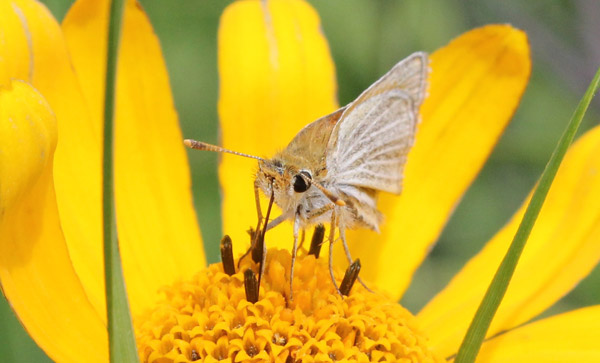
The Poweshiek skipperling was once abundant across America’s prairies. Today only a few hundred may survive. The Minnesota Zoo is working on an effort to save the species. Photo by: Erik Runquist.
Scientists believe that current extinction rates are 100 to 1,000 times the natural rate. Species worldwide are being pummeled by a wide-variety of impacts, but among the biggest include deforestation and habitat loss, overexploitation via hunting and fishing, pollution, and invasive species. Climate change and ocean acidification impacts are rising rapidly and could very well supersede all of the others in the near future. According to Vecchio, given the scale of the problem this is not a time for any zoo or aquarium to sit on the sidelines of the biodiversity crisis, nor is it the time for already-active zoos to become complacent with current efforts.
“I don’t believe sending small amounts of money to existing or start-up field projects is having enough impact. I don’t believe our conservation message to students and visitors is having enough of an impact. I don’t believe we have the expertise or resources to conduct serious work in the field. And, I don’t believe captive breeding programs are anything but a very small piece of a much larger solution,” he said, adding, “All of the above are important tools in the toolbox. But we need more and better tools to be successful.”
Ancient Egyptians built the first none zoo over five thousand years ago. For most of history these institutions have been about showing off animals that were still plentiful and abundant beyond the city walls. But the world has changed: some species—even well known species such as tigers—are more plentiful in captivity than they are in the wild. Today the question remains: how far are zoos willing to push in the efforts to keep animals from vanishing outside their gates? How ambitious, innovative, and even controversial are these age-old institutions willing to become? Will they settle for a few small changes and a little support here-and-there, or will they become a primary force in the effort to save species, save the environment, and in turn save ourselves?
.600.jpg)
A giant armadillo captured on camera trap. Photo by: Kevin Schaefer/the Pantanal Giant Armadillo Project.
Related articles
Death of young Sumatran rhino shouldn’t discourage captive breeding efforts say conservationists

(04/01/2014) Just over two weeks ago, conservationists in the Malaysian state of Sabah managed to finally catch a wild Sumatran rhino female after months of failed attempts. But following such hopeful events, comes bad news thousands of miles away: a young female rhino, named Suci, died over the weekend at the Cincinnati Zoo.
Those eyes look human: could anthropomorphism be used for conservation?

(03/28/2014) It’s easier to relate to someone you have something in common with; that feeling of connection can turn strangers into friends. And if those strangers belong to an entirely different species, then attributing human qualities to that species – a process called anthropomorphism – may aid conservation efforts by attracting public attention and funding resources.
Activists urge Southwest to drop SeaWorld over whale concerns

(01/06/2014) More than 27,000 people have signed a petition calling on Southwest Airlines Co. (LUV) to drop its partnership with SeaWorld Entertainment, Inc. (NYSE:SEAS), over the theme park’s treatment of its marine mammals, reports Change.org, the site that is hosting the petition.
Reversing local extinction: scientists bring the northern bald ibis back to Europe after 300 years

(12/02/2013) The northern bald ibis (Geronticus eremita), also called the hermit ibis or waldrapp, is a migratory bird. Once, the bald ibis lived in the Middle East, northern Africa and southern and central Europe, but due to hunting, loss of habitat and pesticide-use, the birds disappeared from most of these areas and is currently considered Critically Endangered. It became extinct in Europe 300 years ago; the bird is almost gone in Syria, with only a single individual recorded at the country’s lone breeding site in 2013; and the only stronghold left is a small population of around 500 birds in Morocco. But now, a team of scientists from Austria is working to reestablish a self-sustaining, migratory population of bald ibis in Europe.
Zoos join fossil fuel divestment movement
(11/05/2013) Last month, over a hundred representatives from zoos and aquariums around the world joined climate activism group, 350.org, pledging that their institutions would take action against global warming, including the possibility of divesting from fossil fuel companies. The effort, dubbed Zoos and Aquariums for 350, was launched during the annual meeting of the Conservation Breeding Specialist Group (CBSG).
Illegally captured parrots finally free to fly
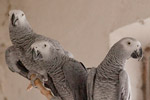
(08/19/2013) In 2010, Bulgarian airport authorities confiscated 108 African grey parrots (Psittacus erithacus) from a smuggler. Last month, the 28 parrots who survived the stress of being stuffed into dog kennels, constantly handled by humans, and the absence of their native habitat, completed their three-year journey to freedom.
Zoo races to save extreme butterfly from extinction
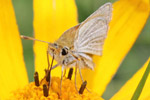
(08/15/2013) In a large room that used to house aquatic mammals at the Minnesota Zoo, Erik Runquist holds up a vial and says, ‘Here are its eggs.’ I peer inside and see small specks, pale with a dot of brown at the top; they look like a single grain of cous cous or quinoa. Runquist explains that the brown on the top is the head cap of the larva, a fact that becomes more clear under a microscope when you can see the encased larva squirm. I’m looking at the eggs of a Poweshiek skipperling, a species that is more imperiled than pandas, tigers, or bluewhales. Once superabundant, only several hundred Poweshiek skipperlings may survive on Earth today and the eggs I’m looking at are the only ones in captivity.
Zoos call on governments to take urgent action against illegal wildlife trade (photos)

(07/24/2013) In a single night in March, a band of heavily-armed, horse-riding poachers slaughtered 89 elephants in southern Chad, thirty of which were pregnant females. The carnage was the worst poaching incident of the year, but even this slaughter paled in comparison to the 650 elephants killed in a Cameroon park in 2012. Elephant poaching is hitting new records as experts say some 30,000 elephants are being killed every year for their ivory tusks. But the illegal wildlife trade—estimated at $19 billion—is not just decimating elephants, but also rhinos, big cats, great apes, and thousands of lesser-known species like pangolins and slow lorises. This growing carnage recently led to representatives of over 40 zoos and dozens of wildlife programs to call on governments around the world to take immediate action on long-neglected wildlife crime.
Should zoos educate the public about climate change?
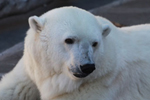
(06/18/2013) Zoos are usually thought of as entertainment destinations. As a place to take the kids on a nice afternoon, they are sometimes perceived to lack the educational heft of an art museum or a theatre. However, over the past few decades many of the world’s best zoos and aquariums have also worked to educate their visitors about conservation issues, in addition to funding and supporting programs in the field to save the ever-growing number of imperiled species. But as threats to the world’s species mount—including climate change—many are beginning to ask what, if anything, zoos and aquariums should do to address the global environmental crisis.
The comeback kids: the role of zoos in saving species from oblivion (photos)
.150.jpg)
(06/03/2013) While many people may view zoos first and foremost as attractions, these institutions have a long history of supporting and instigating conservation work, including saving species from extinction that have vanished from their wild habitat. But such efforts require not just dedication and patience, but herculean organizational efforts. Enter, the World Association of Zoos and Aquariums (WAZA), which works with zoos and aquariums to set up conservation programs and track endangered species in captivity.
Connecting kids through elephants: innovative zoo program links children in the UK and India
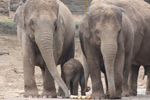
(05/30/2013) You may think children in urban, northern UK have little in common with those in rural Assam, India, but educational connections are possible you just have to know where to look. In this case, an innovative education initiative at Chester Zoo has employed its five ton stars—the Asian elephants—to teach British children about life in faraway India.
Forging zoos into global conservation centers, an interview with Cristian Samper, head of WCS

(03/25/2013) The Wildlife Conservation Society (WCS) is one of the world’s leading environmental organizations. Founded in 1895 (originally as the New York Zoological Society), the WCS manages 200 million acres of wild places around the globe, with over 500 field conservation projects in 65 countries, and 200 scientists on staff. The WCS also runs five facilities in New York City: the Central Park Zoo, the New York Aquarium, Prospect Park and Queens Zoos, and the world renowned Bronx Zoo.
Save Lolita: new film urges release of captive killer whale

(01/22/2013) Through his new 90-second PSA, Save Lolita, filmmaker Daniel Azarian wanted to connect people to the plight of Lolita on a deeply human level; the only problem: Lolita is an orca, also known as a killer whale. But the stark, moving PSA succeeds, given the sociability of an individual—human or orca—who was stolen from her family and held in captivity for the past 42 years at Miami’s Seaquarium.